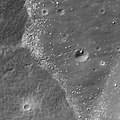File:Lunar Hole In One! (4627171262).jpg

Original file (1,000 × 1,000 pixels, file size: 99 KB, MIME type: image/jpeg)
Captions
Captions
Summary edit
| DescriptionLunar Hole In One! (4627171262).jpg |
English: A house-sized boulder (10 m diameter) rolled down-hill, scoring a hole in one (~60 m diameter crater)! Portion of LROC NAC M122597190L, image width is 500 m across. This scene is located within an approximately 7 km diameter crater that is inside the much larger, ~42 km diameter complex crater Henry Frères.
Golf-enthusiasts might look at today's image and say, "Wow, that boulder sure looks like a hole in one!" Boulders like this are incredible because we can determine where the boulder came from by back-tracking along the boulder trail. In fact, Apollo 17 Astronauts Schmitt and Cernan sampled a large boulder at Station 6, and because scientists were able to trace the original position of this boulder using its boulder trail, we can infer what the composition of the rocks up-slope may be. In this case, the boulder trail curves abruptly as the boulder approached its final resting place. What might have caused this boulder to deviate from its straight, downward course? You can see the boulder trail intersects a crater rim as the local slope was flattening out. As the boulder was slowing, it encountered a new steep slope on its right, thus turning it into the crater. Boulders fall from high elevations to lower ones because of gravity after being knocked loose by small impacts or moonquakes. Changes in slope can stop boulders; when a steep slope (like that of a crater wall) suddenly shallows, the boulder may not have enough inertia to continue moving. Inertia, or Newton's First Law of Motion, describes an object's resistance to change in velocity. So, a boulder will continue to move until something changes its speed or direction. |
| Date | (released) |
| Source | Lunar Hole In One!; see also https://www.nasa.gov/mission_pages/LRO/multimedia/lroimages/20100520_holeinone.html |
| Author | NASA/GSFC/Arizona State University |
Licensing edit
| Public domainPublic domainfalsefalse |
| This file is in the public domain in the United States because it was solely created by NASA. NASA copyright policy states that "NASA material is not protected by copyright unless noted". (See Template:PD-USGov, NASA copyright policy page or JPL Image Use Policy.) |  | |
 |
Warnings:
|
- You are free:
- to share – to copy, distribute and transmit the work
- to remix – to adapt the work
- Under the following conditions:
- attribution – You must give appropriate credit, provide a link to the license, and indicate if changes were made. You may do so in any reasonable manner, but not in any way that suggests the licensor endorses you or your use.
| This image was originally posted to Flickr by NASA Goddard Photo and Video at https://flickr.com/photos/24662369@N07/4627171262 (archive). It was reviewed on 11 May 2018 by FlickreviewR 2 and was confirmed to be licensed under the terms of the cc-by-2.0. |
11 May 2018
File history
Click on a date/time to view the file as it appeared at that time.
| Date/Time | Thumbnail | Dimensions | User | Comment | |
|---|---|---|---|---|---|
| current | 23:52, 11 May 2018 |  | 1,000 × 1,000 (99 KB) | OceanAtoll (talk | contribs) | Transferred from Flickr via #flickr2commons |
You cannot overwrite this file.
File usage on Commons
The following page uses this file:
Metadata
This file contains additional information such as Exif metadata which may have been added by the digital camera, scanner, or software program used to create or digitize it. If the file has been modified from its original state, some details such as the timestamp may not fully reflect those of the original file. The timestamp is only as accurate as the clock in the camera, and it may be completely wrong.
| Image title |
|
|---|---|
| Keywords |
|
| IIM version | 4 |